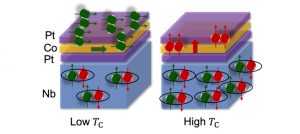Title: Superspintronics – Towards Ultra-low Dissipation Spin-electronics.
When: Thursday, December 12, (2019), 12:00.
Place: Department of Condensed Matter Physics, Faculty of Sciences, Module 3, Seminar Room (5th Floor).
Speaker: Niladri Banerjee, Department of Physics, Loughborough University, United Kingdom.
The fundamental antagonism between superconductivity and ferromagnetism arises from the nature of electron pairing in these materials – parallel for ferromagnetism and antiparallel (singlet) for superconductivity. However, recent theoretical and experimental evidences [1] suggest a unique form of odd-frequency equal-spin (triplet) superconductivity that arises at carefully engineered interfaces between ferromagnets and superconductors. These equal-spin Cooper pairs are immune to the pair breaking exchange field in a ferromagnet and can propagate over length scales which are significantly longer than the singlet pair coherence lengths. These dissipationless triplet currents carry a net spin which raises the intriguing possibility of ultra-low-dissipation superconducting spin-electronics (superspintronics) [2].
In this talk, following a brief introduction, I will discuss recent progress in this area [2-7], specifically focussing on two recent results: spin-orbit coupling-driven superspintronics [5,6] and magnetisation reorientation due to superconducting transition [7]
References
- J. Linder and J. W. A. Robinson, Nature Physics 11, 307–315 (2015).
- N. Banerjee, Physics World, Volume 32, Number 4 (2019).
- N. Banerjee et al., Nature Communications 5:4771 (2014).
- N. Banerjee et al., Nature Communications 5:3048 (2014).
- N. Banerjee et al., Phys. Rev. B 97, 184521 (2018).
- I. Martínez et al. arXiv:1812.08090, (2019).
- L. G. Johnsen et al., Phys. Rev. B 99, 134516 (2019).

